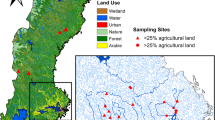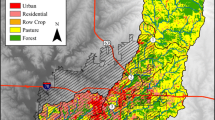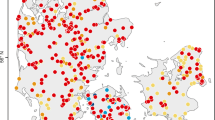Abstract
Measurement of total suspended solids (TSS) and total dissolved solids (TDS) loadings in streams is often used to assess potential impacts from mining on surface water quality within a drainage basin. It has been suggested that TSS could be used as an indicator to estimate TDS loading through the use of a TDS/TSS ratio. The reliability of this approach was tested by examining empirical linear relationships between TSS and TDS loads at three locations within a mining-influenced watershed in Colorado. Predictive accuracy of the relationships was assessed using an independent source of data for the same locations, with comparisons between estimated and observed TDS loads for periods within and outside the years used to develop relationships. Evaluations were conducted over the entire flow regime and for separate periods of low- and high-flow. Improved representation of the data was achieved by incorporation of a regressed average baseflow contribution, indicating the relationship between TDS and TSS loads is not accurately represented by a simple ratio. High variability in data between locations prevents application of a basin scale relationship to all locations within that basin. Local-scale relationships developed under specific flow regimes resulted in more accurate predictions, but results suggest that factors additional to flow may need to be considered to improve predictability. Usefulness of linear empirical relationships to predict TDS load from TSS load will depend on the magnitude of uncertainty that is tolerable for a given situation.
抽象
测量河流总悬浮固体(TSS)和总溶解固体(TDS)荷载以评价采矿对下游河流水体质量的潜在影响。已有研究表明总溶解固体与总悬浮固体的比值(TDS/TSS)可用以估算总溶解固体(TDS) 荷载。通过检验科罗拉多州受采矿影响的三个流域内取样点的TSS与TDS经验线性关系,验证了该方法的可靠性。用同一地点的独立数据评价了TSS与TDS的预测精度,对比了建立TSS与TDS预测关系前后的TDS预测值与实测值。分丰水期和枯水期评价了整个流域TDS荷载。整合回归平均基流使数据代表性增强,表明TDS和TSS的简单比值并不能精确代表二者关系。数据随地点的变异特征限制了流域尺度TDS与TSS关系在整个盆地内的应用。TDS与TSS局部特定关系的预测精度更高,同时还需要考虑水流之外的其它因素影响。应用TDS与TSS经验线性关系预测TDS的有效性依赖于给定条件下接受结果非确定性的程度。
Zusammenfassung
Messungen der gesamten Schwebstoff-Fracht (TSS) und der Gesamtsumme gelöster Feststoffe (TDS) in Wasserläufen werden genutzt, um mögliche Auswirkungen des Bergbaues auf die Qualität der Oberflächenwässer in einem Wassereinzugsgebiet zu bewerten. Es wurde vermutet, dass TSS als Indikator für eine Abschätzung von TDS unter Nutzung des TDS/TSS Quotienten verwendet werden könnte. Die Zuverlässigkeit dieses Vorgehens wurde überprüft, indem die empirische lineare Beziehung zwischen TSS und TDS an drei Lokationen in einem bergbaubeeinflussten Wassereinzugsgebiet in Colorado untersucht wurde. Die Vorhersagegenauigkeit der Beziehungen wurde an Hand einer unabhängigen Datenquelle für die selben Lokationen geprüft, mit Vergleichen zwischen den geschätzten und den gemessenen TDS Frachten während Perioden innerhalb und außerhalb der Jahre, welche für die Entwicklung der Beziehungen genutzt wurden. Auswertungen wurden über das gesamte Abflussregime und für getrennte Perioden hoher und niedriger Fließraten unternommen. Verbesserte Darstellung der Daten wurde durch Einbeziehen von durchschnittlichem Basisabfluß erreicht, welcher durch Regression berechnet wurde. Dies zeigte, dass die Beziehung zwischen TDS und TSS Frachten durch einen einfachen Quotienten nicht genau dargestellt werden kann. Hohe Variabilität der Daten zwischen Lokationen verhindert die Anwendung einer Beziehung für das ganze Abflussbecken für alle Orte innerhalb des Beckens. Lokale Beziehungen, welche unter spezifischen Fliessbedingungen enstehen, ergeben genauere Vorhersagen, aber die Resultate deuten an, dass neben dem Fliessen möglicherweise weitere Faktoren einbezogen werden sollten, um die Vorhersagbarkeit zu verbessern. Die Nützlichkeit linearer empirischer Beziehungen zur Vorhersage der TDS Fracht aus TSS Daten hängt von der Höhe der Ungewissheit ab, welche in einer gegebenen Situation toleriert werden kann.
Resumen
Las mediciones de los sólidos totales en suspensión (TSS) y los sólidos totales disueltos (TDS) presentes en cursos de agua es usado para relevar los potenciales impactos de la minería sobre la cualidad del agua de superficie dentro de una cuenca de drenaje. Se ha sugerido que TSS podría ser un indicador para estimar TDS a través del uso de la relación TDS/TSS. La confiabilidad de esta aproximación fue testeada examinando relaciones empíricas lineales entre TSS y TDS en tres lugares dentro de una cuenca afectada por la minería en Colorado. La precisión de la predicción que permite esta relación fue relevada usando una fuente independiente de datos en los mismos lugares, con comparaciones entre los TDS observados y estimados por períodos dentro y fuera de los años usados para desarrollar las relaciones. Las evaluaciones fueron realizadas sobre todo el régimen de flujo y para períodos separados de flujo bajo y alto. Se alcanzó una representación mejorada de estos datos con la incorporación de una contribución promedio del flujo base, indicando que la relación entre TDS y TSS no es representada de manera precisa por una simple relación. La alta variabilidad en los datos según los lugares impide la aplicación de esta relación en todos los lugares dentro de la cuenca. Relaciones a escala local desarrolladas bajo regímenes de flujo específicos resultaron en predicciones más precisas, pero los resultados sugieren que los factores adicionales al flujo son necesarios para mejorar la predictibilidad. La utilidad de las relaciones empíricas lineales para predecir TDS a partir de TSS dependerá de la magnitud de la incerteza que es tolerable para la situación dada.






Similar content being viewed by others
References
Bilotta GS, Brazier RE (2008) Understanding the influence of suspended solids on water quality and aquatic biota. Water Res 41:2849–2861
Boving TB, Neary K (2006) Testing the efficiency of a stormwater runoff treatment structure with anthropogenic tracers. Environ Eng Geosci 12:115–124
Brinkmann WLF (1983) Dissolved and suspended loads of the regulated River Nidda in the Rhine-Main area. In: Webb BW (ed) Dissolved loads of rivers and surface water quantity/quality relationships; proceedings of a symposium, Hamburg (Germany, F.R.), 15–27 August. International Assoc of Hydrological Sciences, IAHS Publ 141, pp 347–357. http://hydrologie.org/redbooks/a141/iahs_141_0347.pdf. Accessed 8 June 2016
Butler BA, Ranville JF, Ross PE (2008) Direct versus indirect determination of suspended sediment associated metals in a mining-influenced watershed. Appl Geochem 23:1218–1231
Butler BA, Ranville JF, Ross PE (2009) Spatial variations in the fate and transport of metals in a mining-influenced stream, North Fork Clear Creek, Colorado. Sci Total Environ 407:6223–6234
Byrne P, Wood PJ, Reid I (2012) The impairment of river systems by metal mine contamination: a review including remediation options. Crit Rev Env Sci Tec 42:2017–2077
Church SE, Kimball BA, Fey DL, Ferderer DA, Yager TJ, Vaughn RB (1997) Source, transport, and partitioning of metals between water, colloids, and bed sediments of the Animas River, Colorado. U.S. Geological Survey Open-File Report 97–0151. https://pubs.usgs.gov/of/1997/ofr-97-0151/. Accessed 25 April 2017
Einsele G (1992) Sedimentary Basins: Evolution, Facies, and Sediment Budget. Springer, Germany
Ferderer DA (1996) National overview of abandoned mine land sites utilizing the minerals availability system (MAS) and geographic information system (GIS) technology. U.S. Geological Survey Open-File Report 96–549, https://pubs.usgs.gov/of/1996/0549/report.pdf. Accessed 1 May 2017
Fritz SJ (1994) A survey of charge-balance errors on published analyses of potable ground and surface waters. Ground Water 32:539–546
Gupta SK (2011) Modern hydrology and sustainable water development. Wiley-Blackwell, UK
Hudson-Edwards KA (2003) Sources, mineralogy, chemistry and fate of heavy metal-bearing particles in mining-affected river systems. Mineral Mag 67:205–217
Kimball BA, Runkel RL, Walton-Day K (2010) An approach to quantify sources, seasonal change, and biogeochemical processes affecting metal loading in streams: facilitating decisions for remediation of mine drainage. Appl Geochem 25:728–740
Milliman JD (1997) Fluvial sediment discharge to the sea and the importance of regional tectonics. In: Ruddiman WF (ed) Tectonic uplift and climate change. Plenum Press, New York, pp 239–258
Milliman JD, Farnsworth KL (2011) river discharge to the coastal ocean. A global synthesis. Cambridge University Press, New York City
Ran L, Lu XX, Sun H, Han J, Yu R (2015) Chemical denudation in the Yellow River and its geomorphological implications. Geomorphology 231:83–93
Rice EW, Baird RB, Eaton AD, Clesceri LS (eds) (2012) Standard Methods for the Examination of Water and Wastewater. 22nd Edition, Method 2540, American Public Health Assoc. American Water Works Assoc, Water Environment Federation, Washington, DC
Sauer VB, Meyer RW (1992) Determination of error in individual discharge measurements. Open-file Report 92–144, USGS, Norcross, Georgia, http://pubs.usgs.gov/of/1992/ofr92-144/pdf/ofr92-144.pdf. Accessed 8 June 2016
Society of Environmental Toxicology and Chemistry (2004) Technical issue paper: whole effluent toxicity testing: ion imbalance. SETAC, Pensacola. https://c.ymcdn.com/sites/www.setac.org/resource/resmgr/publications_and_resources/tip-ion.pdf. Accessed 24 April 2017
Topping J (1972) Errors of observation and their treatment, 4th edn. Chapman and Hall, London
Troxel CF (2013) Life cycle analysis of sediment control devices. MS Thesis, Georgia Institute of Technology. http://hdl.handle.net/1853/49105. Accessed 24 May 2016
Upper Clear Creek Watershed Association (2014) Clear Creek Watershed Plan Update. https://www.colorado.gov/pacific/sites/default/files/CCWatershedPlan_02-06-14_FINAL.pdf. Accessed 24 April 2017
USGS (U.S. Geological Survey) (2016a) The National Map, 3DEP products and services: The National Map, 3D Elevation Program Web page. http://nationalmap.gov/3DEP/3dep_prodserv.html. Accessed 24 April 2017
USGS (2016b) National water information system data available on the World Wide Web USGS Water Data for the Nation. http://waterdata.usgs.gov/nwis/sw. Accessed 8 June 2016
Weber-Scannell PK, Duffy LK (2007) Effects of total dissolved solids on aquatic organisms: a review of literature and recommendation for Salmonid species. Am J Environ Sci 3:1–6
Weiner ER (2013) Applications of environmental aquatic chemistry: a practical guide, 3rd edn. CRC Press, Florida
Acknowledgements
The authors thank Tim Steele (TDS Consulting, Denver, CO) for providing the Upper Clear Creek Watershed Association water quality monitoring data to allow testing of relationships, and Drs. Brian Dyson and William Shuster at U.S. EPA and the anonymous reviewers for their helpful review comments. This manuscript has been administratively reviewed and approved for publishing. Citations of product, company, or trade names do not constitute endorsement by the U.S. Environmental Protection Agency and are provided only for the purpose of better describing information in this manuscript.
Author information
Authors and Affiliations
Corresponding author
Electronic supplementary material
Below is the link to the electronic supplementary material.
Rights and permissions
About this article
Cite this article
Butler, B.A., Ford, R.G. Evaluating Relationships Between Total Dissolved Solids (TDS) and Total Suspended Solids (TSS) in a Mining-Influenced Watershed. Mine Water Environ 37, 18–30 (2018). https://doi.org/10.1007/s10230-017-0484-y
Received:
Accepted:
Published:
Issue Date:
DOI: https://doi.org/10.1007/s10230-017-0484-y




